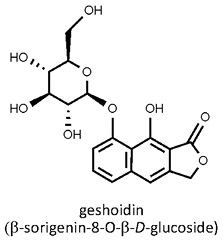 Rhamnus prinoides
Rhamnus prinoides
geisho • gesho
Back to “Culinary herbs: geisho (Rhamnus prinoides)*”
Rhamnus prinoides L.’Herit. (Rhamnaceae); geisho, blinkblaar (Afrikaans); geisho, gesho (Amharic); geisho (French)
DESCRIPTION Geisho is the dried leaves and twigs, often with some flowers or berries included. The leaves are oblong, taper to a narrow tip and have small teeth along the margins. The taste is bitter and the aroma is faintly woody and spicy.
THE PLANT Geisho is a shrub or small tree, up to 6 m (20 ft) high but often not exceeding 1.5 m (5 ft) when cultivated and regularly harvested. The leaves are alternately larger and smaller along the stems. Small yellowish green flowers develop into small fleshy red drupes that become blackish-purple when ripe.1
ORIGIN Indigenous to Arabia and sub-Saharan Africa, from southern Africa to Ethiopia.1 It is an ancient Ethiopian crop that still plays an important role in the rural economy.2–4
CULTIVATION Traditionally, seedlings were collected from below wild-growing trees but nowadays selected seeds are used in nurseries to produce plants in containers. They are transplanted and grown in pure stands or may be intercropped with maize, vegetables and other plants.4 Trees grow well at relatively high altitudes and are resistant to frost but not to drought. Important centres for geisho production include Tigray, North Shoa and the area around Sebeta near Addis Ababa.4,5
HARVESTING Plants should be at least three years old before they are first harvested. Geisho is traditionally collected by stripping all the leaves, leaving only those on the branch tips.4 Cultivated plants can stay productive for up to 50 years or more.4
CULINARY USES Geisho is used to flavour traditional Ethiopian alcoholic beverages that are produced and sold everywhere in Ethiopia. The two main products are traditional beer (tella) and mead (tej) but a traditional home-brewed spirit drink known as areki or katikala is also made.4 Geisho is used as bitter flavourant, similar to hops in German-style barley-based beers. The fermentation starter for making traditional beer is called tinses. It is made from powdered geisho leaves and stems (with all fruits carefully removed) added to water, together with a small amount of malted grain (usually barley).4,5 The traditional beer or tella (called sewa in Tigrinya) is brewed from sorghum, maize or finger millet. Tej is also known as mies. It is a delicious traditional mead or honey beer/wine, made from local honey, often produced in traditional woven beehives.
FLAVOUR COMPOUNDS The bitter taste of geisho is due to geshoidin (β-sorigenin-8-O-β-D-glucoside), a napthalenic glycoside.5 It is possible that various other compounds (e.g. physcion, prinoidin, rhamnocitrin and rhamnazin)5 also contribute to the flavour and aroma.

NOTES Tej is served in a traditional tej glass, known as a berele, in rural and urban tej houses (called tej betoch).
1. Vollesen, K. 1989. Rhamnaceae. In: Hedberg, I., Edwards, S. (Eds), Flora of Ethiopia and Eritrea, Vol. 3, pp. 385–398. National Herbarium, Addis Ababa and University of Uppsala, Uppsala.
2. Jansen, P.C.M. 1981. Spices, condiments and medicinal plants in Ethiopia, their taxonomy and agricultural significance. Agricultural Research Reports 906. Centre for Agricultural Publishing and Documentation, Wageningen.
3. Pankhurst, R. 1968. Economic history of Ethiopia, p. 194. Haile Selassie I University, Addis Ababa.
4. Vetter, S. 1997. Geisho, its uses, production potential and problems in northern Tigray, Ethiopia. Institute for Sustainable Development, Addis Ababa.
5. Abegaz, B.M., Kebede, T. 1995. Geshoidin: A bitter principle of Rhamnus prinoides and other constituents of the leaves. Bulletin of the Chemical Society of Ethiopia 9: 107−114.